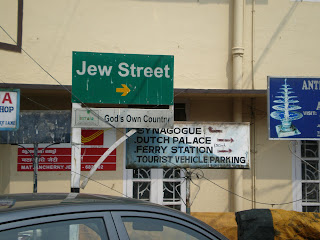
How the Jews actually came to the shores of Kerala is not clear. The ten rupee brochure I picked up in Jew Town, tells me that the Jews made their home in Kodungallur (or Cranganore)in Thrissur district of Kerala. This port town was destroyed in a flood in 1340 AD and that's how the Jews reached Cochin. There is also mention of their persecution by the Portuguese. The city gained prominence as a major spice destination. In fact, the Pepper Exchange is located in Jew Town in the old quarter of present day Cochin. (The building right behind the signpost in the picture is the Pepper Exchange)

Jew Town is a narrow street, lined with shops selling handicrafts on either side. The houses have a European feel to them. I suppose it is the Portuguese and Dutch influence. At the end of the street is located the Paradesi Synagogue. Wikipedia says that the Paradesi Synagogue of Cochin is the oldest synagogue in the commonwealth of nations and was built in 1568 AD. It got the name Paradesi, (meaning 'foreigner') since it was built under Dutch patronage and used by 'White Jews' (a mixed Jewish community consisting of the Jews from Cranganore, Middle East and Europe). The dominating feature of the synagogue is a clock tower which was built in the 18th century.

We entered from the side, after reading a board that cautioned visitors about the dress code. The floor of the synagogue was laid with Chinese tiles. At first glance they looked identical. We were later told that each one was different from the other. There should have been at least a hundred tiles on the floor!

Inside the synagogue, a volunteer then proceeded to give us a brief history. We were surprised to learn that it is being maintained by members of ten Jewish families who still lived in the area. The gentleman was extremely patient with the questions asked by the tourists. (The ignorance was palpable. Eg. Are Jews different from Christians?-not me I promise!). On the way back, we learned that mail from the local post office was post marked with the Magen David. I wasted no time in sending off a post card to my 11 year old niece. (I have a fond wish to contribute towards the broadening of her mind!)

From there we visited the St. Francis Church, famous for housing the mortal remains of Vasco Da Gama before it was moved to Lisbon 14 years later. Built by the Portuguese,it was orginally a Catholic Church. After Dutch occupation, it was converted into a Protestant Church. A sign proclaimed that this was the oldest European church in India. My husband immediately contested this, claiming that the Luz Church in Chennai was the oldest church in India. I do not know which is the real claim.
We then walked towards the water to watch Chinese fishing nets being lowered and lifted from the water. Have you ever seen these nets? They look incredible. Like giant spiders hanging over the water. Made of simple materials. Just long pieces of wood, joined together and nets strung across them, I could watch these cantilever nets forever! Local lore has it that it was introduced in Kerala by Chinese traders from the court of Kublai Khan. One website claims that these are the only Chinese fishing nets seen outside China. True or not, these nets provide wonderful Kodak moments!Any tourist to Kerala would have at least one picture of a Chinese fishing net against the backdrop of the setting sun.

Done with imbibing the sites and culture of Cochin, my husband and I returned to our hotel, grubby and tired but happy. Till we boarded the steel trap that is also known as the Garib Rath Express to Calicut. But thats another post!









